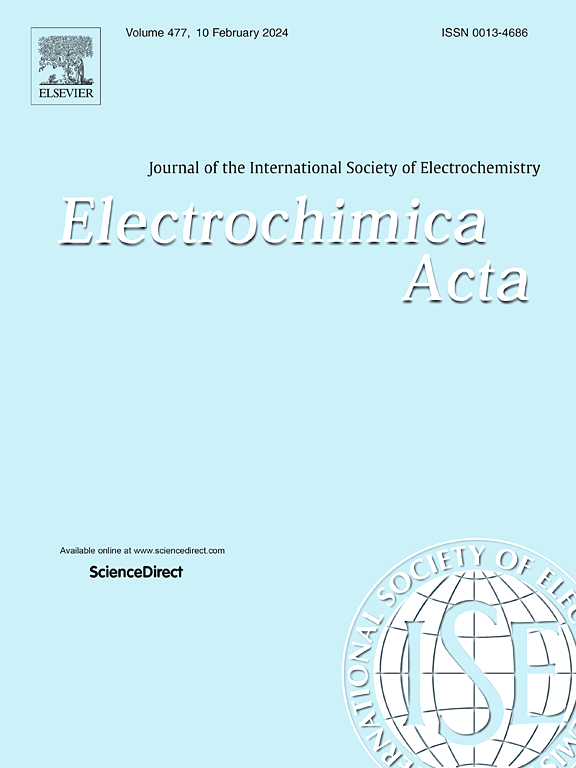Microneedle array integrated 2D NiSe2/MXene-based real-time urea sensing in interstitial fluid
IF 5.5
3区 材料科学
Q1 ELECTROCHEMISTRY
引用次数: 0
Abstract
Although there has been a lot of work towards the development of urea sensors, work towards the development of non-invasive or minimally invasive biosensors for personal healthcare remains scarce. Microneedle (MN)-based diagnostic presents a new avenue in personalized healthcare monitoring by utilizing interstitial fluid (ISF) as a biofluid and a viable alternative to conventional blood-based diagnostics. This work demonstrates the development of a wearable electrochemical sensor coupled with poly (ethylene glycol) diacrylate (PEDGA) based MN extraction platform to realize minimally invasive ISF-based real-time highly selective urea monitoring. The MNs with an average length of 782±10 µm are fabricated using stereolithography and the electrochemical enzymatic sensor is developed using a flexible carbon cloth (CC) electrode modified with NiSe2/MXene.The modified Urease/NiSe2/MXene/CC electrode exhibits a high sensitivity of 83.49 μAμM-1cm-2 (1 μM to 20 μM), 70 μAμM-1cm-2 (0.1 mM to 1 mM) and 20 μA mM-1 cm-2(0.1 mM to 15 mM), with high selectivity, with a response time of 398 s, and the lowest detection limit of 0.1214 μM. Further, the validation of urea concentration in ISF with the developed sensor with the standard clinical method named Glutamate dehydrogenase (GLDH) suggests an error in the tolerable range. Finally, in-vivo studies of urea measurement were performed by inserting a 3D printed MN patch (10×10) in Sprague Dawley (SD) rat’s dorsal skin. The in-vivo studies revealed a urea concentration of ∼ 5.8 mM with a rapid response time of 398 s, which is exceptionally faster, and validated using the GLDH method. Successful demonstration for minimally invasive MN-based point-of-care diagnostic of biomarkers opens up new avenues of development for personal healthcare monitoring.
微针阵列集成二维NiSe2/ mxeni间质液实时尿素传感
虽然尿素传感器的开发已经有了很多工作,但用于个人医疗保健的非侵入性或微创生物传感器的开发工作仍然很少。基于微针(MN)的诊断通过利用间质液(ISF)作为生物流体和传统血液诊断的可行替代方案,为个性化医疗监测提供了新的途径。本研究展示了一种可穿戴电化学传感器与基于聚乙二醇二丙烯酸酯(PEDGA)的MN提取平台耦合的发展,以实现基于isf的微创实时高选择性尿素监测。采用立体光刻技术制备了平均长度为782±10µm的纳米颗粒,并采用nis2 /MXene修饰的柔性碳布(CC)电极开发了电化学酶传感器。改性脲酶/NiSe2/MXene/CC电极的灵敏度分别为83.49 μ μ m- ccm -2(1μM ~ 20μ m)、70 μAμ m- ccm -2(0.1mM ~ 1mM)和20 μA mM-1 cm-2(0.1mM ~ 15mM),具有较高的选择性,响应时间为398 s,最低检出限为0.1214μM。此外,用标准临床方法谷氨酸脱氢酶(GLDH)对ISF中尿素浓度的验证表明,该传感器在可耐受范围内存在误差。最后,通过在SD大鼠背部皮肤中插入3D打印MN贴片(10*10)进行体内尿素测量研究。体内研究表明,尿素浓度为~ 5.8 mM,快速响应时间为398秒,这是非常快的,并使用GLDH方法验证。成功展示了基于mn的生物标志物的微创即时诊断,为个人医疗监测开辟了新的发展途径。
本文章由计算机程序翻译,如有差异,请以英文原文为准。
求助全文
约1分钟内获得全文
求助全文
来源期刊

Electrochimica Acta
工程技术-电化学
CiteScore
11.30
自引率
6.10%
发文量
1634
审稿时长
41 days
期刊介绍:
Electrochimica Acta is an international journal. It is intended for the publication of both original work and reviews in the field of electrochemistry. Electrochemistry should be interpreted to mean any of the research fields covered by the Divisions of the International Society of Electrochemistry listed below, as well as emerging scientific domains covered by ISE New Topics Committee.
 求助内容:
求助内容: 应助结果提醒方式:
应助结果提醒方式:


